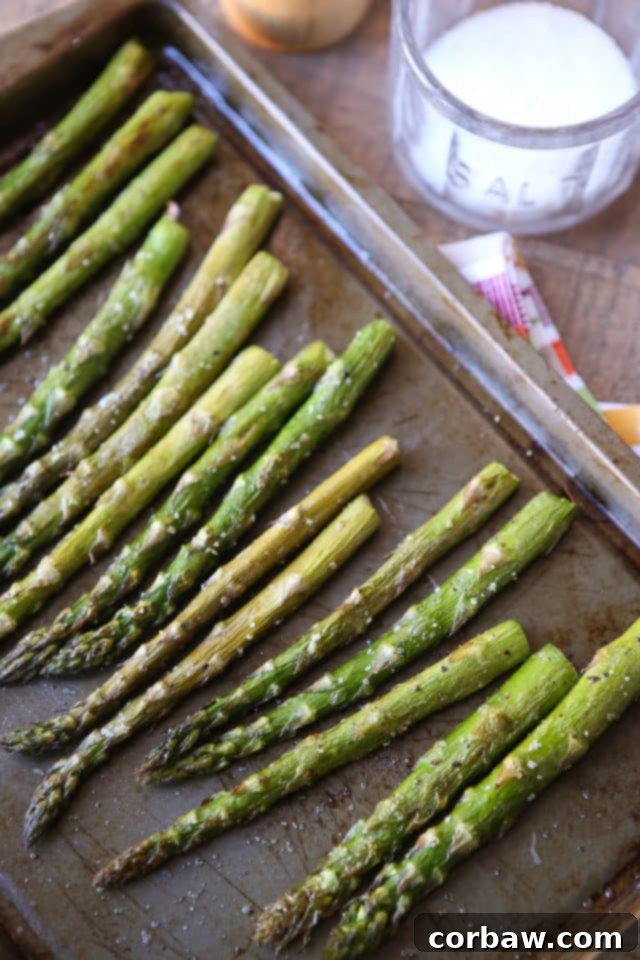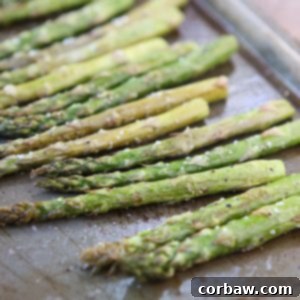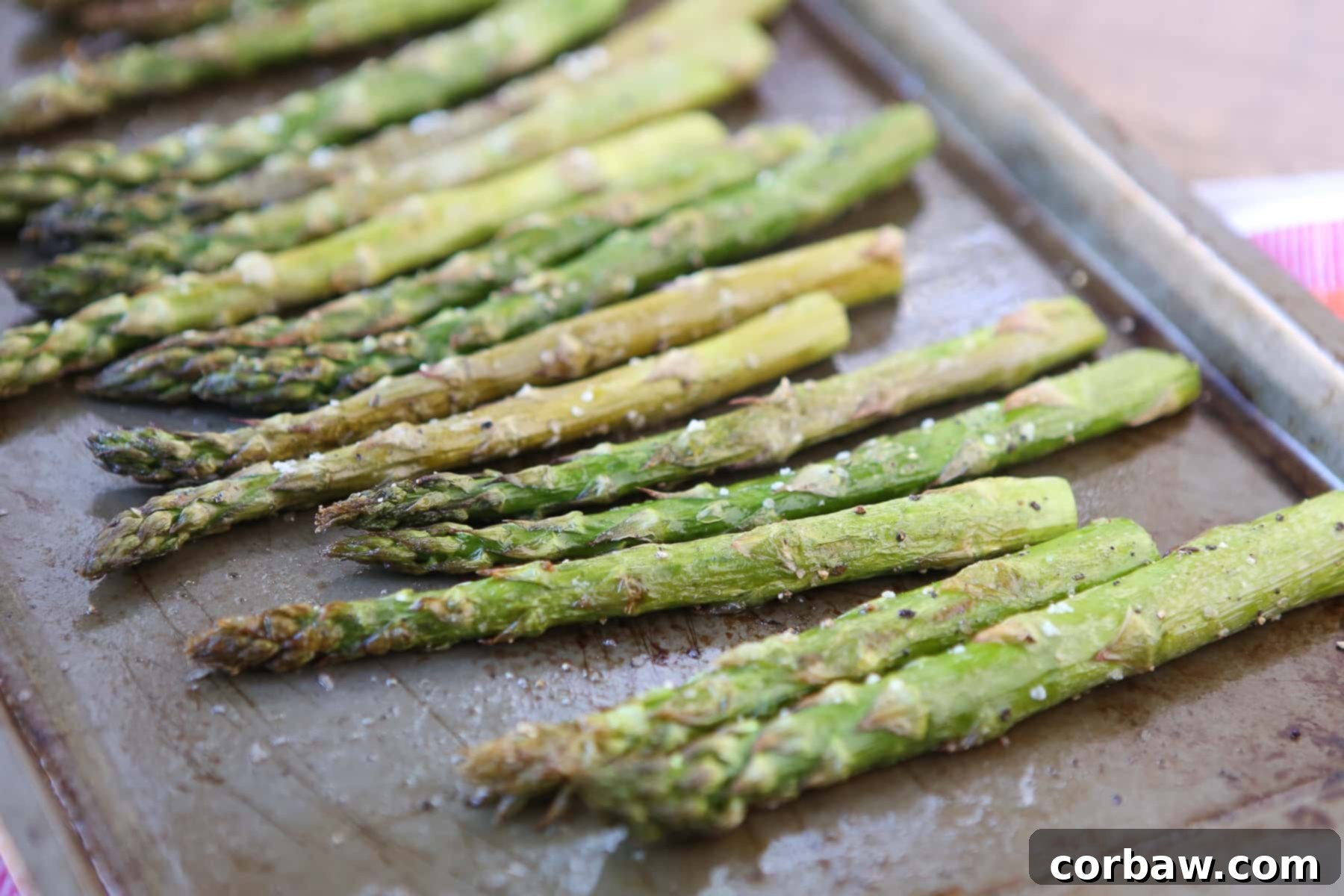Effortlessly Delicious: The Ultimate Guide to Perfect Oven Roasted Asparagus
This Roasted Asparagus recipe is an easy way to get this popular spring vegetable on the table at dinner time. Seasoned simply with just olive oil, salt and pepper and roasted to perfection in the oven.
Click here to Pin this easy Roasted Asparagus recipe!

As the days grow longer and the weather warms, there’s a particular joy that comes with seeing fresh asparagus emerge in grocery stores and farmers’ markets. After months of heartier root vegetables, the vibrant green spears of asparagus are a true harbinger of spring, signaling a return to lighter, fresher flavors. This simple oven-roasted asparagus recipe is an absolute staple in our kitchen during this season, offering an incredibly easy and foolproof way to enjoy this delightful vegetable.
You know it’s spring when you see bunches of asparagus popping up everywhere at the grocery store. After a long season of winter squashes and sweet potatoes (with all due respect), it’s one of my favorite sights to see in the produce section. For many, asparagus holds a special place, often associated with holiday meals like Easter lunch. Growing up, it was the one vegetable I always looked forward to on our Easter table, a much-anticipated treat rather than an everyday staple. Its seasonal appearance made it feel all the more precious.
Nowadays, asparagus is readily available, and its versatility means it can be enjoyed far beyond just special occasions. My preferred method for preparing it is wonderfully straightforward: simply roasted in the oven with a drizzle of olive oil, a generous sprinkle of coarse salt, and a dash of freshly ground pepper. This minimal seasoning allows the natural, slightly earthy, and subtly sweet flavor of the asparagus to truly shine through. For those looking for an extra touch, a sprinkle of a breadcrumb and Parmesan mixture right at the end of its cook time adds a delightful crunch and savory boost, elevating a simple side dish into something truly special.
Unlocking the Nutritional Powerhouse: Health Benefits of Asparagus
It’s no secret that asparagus is a powerhouse when it comes to nutrition. Beyond its delicious taste and appealing texture, incorporating asparagus into your diet offers a myriad of health benefits, making it an excellent choice for a healthy side dish or a versatile addition to countless meals. This spring vegetable packs a significant nutritional punch, supporting overall well-being in several key areas:
- **Good Source of Fiber:** Asparagus is rich in both soluble and insoluble fiber. Dietary fiber is crucial for digestive health, promoting regularity and preventing constipation. It also contributes to satiety, helping you feel fuller for longer, which can be beneficial for weight management. Furthermore, the fiber in asparagus acts as a prebiotic, feeding the beneficial bacteria in your gut and fostering a healthy microbiome.
- **Natural Diuretic:** Asparagus has natural diuretic properties, thanks in part to its high water content and specific compounds like asparagine. This means it can help flush excess fluid and sodium from the body, potentially reducing bloating and supporting kidney function. This natural detoxification can contribute to a feeling of lightness and overall wellness.
- **High in Folate and Vitamin K:** Asparagus is an excellent source of Folate (Vitamin B9) and Vitamin K. Folate is essential for cell growth and DNA formation, playing a critical role in preventing neural tube defects during pregnancy and supporting cardiovascular health. Vitamin K is vital for blood clotting, ensuring proper wound healing, and also plays a significant role in bone health by aiding in calcium absorption and bone mineralization.
- **Anti-inflammatory Properties:** The vibrant green spears of asparagus contain a variety of phytonutrients, including saponins, flavonoids, and various antioxidants, which contribute to its anti-inflammatory effects. Chronic inflammation is linked to numerous health issues, so consuming foods with anti-inflammatory properties can help reduce the risk of diseases like heart disease, diabetes, and certain cancers.
- **Rich in Antioxidants:** Asparagus is loaded with antioxidants, including Vitamin E, Vitamin C, glutathione, and various flavonoids. These powerful compounds combat oxidative stress in the body by neutralizing free radicals, which are unstable molecules that can damage cells and contribute to aging and disease. A diet rich in antioxidants helps protect cells from damage and supports overall cellular health.
- **Source of Essential Vitamins and Minerals:** Beyond the key nutrients listed, asparagus also provides a good amount of Vitamin A (in the form of beta-carotene, important for vision and immune function), Vitamin C (another potent antioxidant and immune booster), potassium (essential for blood pressure regulation), and chromium (a trace mineral that helps regulate blood sugar levels).
With such an impressive nutritional profile, it’s clear why asparagus is more than just a delicious spring vegetable—it’s a valuable addition to any healthy diet.

Mastering the Art of Oven Roasted Asparagus: Preparation & Cooking Tips
Achieving perfectly tender-crisp roasted asparagus is incredibly simple, but a few key steps can make all the difference. From selecting the freshest stalks to proper seasoning, here’s how to prepare and cook this delightful vegetable like a seasoned chef.
Selecting the Best Asparagus
The foundation of any great dish starts with quality ingredients. When choosing asparagus, look for firm, bright green spears with tight, closed tips. Avoid bunches that appear limp, withered, or have flowering tips, as these indicate older asparagus that will be less tender and flavorful. Both thin and thick spears work well for roasting, but keep in mind that thicker spears will require a slightly longer cooking time than thinner ones.
Trimming Asparagus Like a Pro
Before you even think about seasoning, proper trimming is essential. To prepare asparagus, first rinse the spears well under cool running water to remove any dirt. Place them on a clean kitchen towel to dry completely; excess moisture can lead to steaming instead of roasting. Next, you need to remove the tough, woody ends of the stalk. The easiest and most natural way to do this is by taking an individual spear and bending it until it naturally snaps. It will usually break easily and naturally where the tender stalk begins. This method ensures you only keep the edible, tender portion. Alternatively, you can line up the asparagus spears on a cutting board and slice off the bottom inch or two with a knife, which is quicker if you’re preparing a large quantity.
Seasoning for Success
Once your asparagus is clean and trimmed, it’s time for seasoning. I like to season the asparagus directly on the baking sheet for minimal cleanup. Drizzle a tablespoon of good quality olive oil over the asparagus. Using your hands, gently toss the spears to ensure they are evenly coated with the oil. The olive oil helps the asparagus roast to a beautiful golden brown and carries the flavors of the seasonings. A generous sprinkle of coarse salt and freshly ground black pepper is next. These basic seasonings enhance the natural sweetness of the asparagus without overpowering it. Feel free to add a pinch of garlic powder or onion powder for an extra layer of flavor if you wish.
Roasting to Perfection
Once seasoned, the asparagus goes into a hot oven. Roasting at a high temperature (around 400-450°F or 200-230°C) is key to achieving that desirable tender-crisp texture with slightly caramelized edges. This quick, high-heat method brings out the best in the vegetable. Spread the asparagus in a single layer on the baking sheet; overcrowding the pan can cause the asparagus to steam instead of roast, resulting in a less desirable texture. Cook for approximately 10-15 minutes, depending on the thickness of your spears. Thin asparagus might be done in as little as 8-10 minutes, while thicker spears could take up to 15-18 minutes. The asparagus is perfectly roasted when it’s tender enough to be easily pierced with a fork but still retains a slight crispness, and the tips are lightly browned and slightly charred. Keep a close eye on it, as overcooked asparagus can become limp and mushy.

Delicious Pairings: What to Serve with Oven Roasted Asparagus
One of the best qualities of oven roasted asparagus is its incredible versatility. Its clean, fresh flavor and tender-crisp texture make it a perfect complement to a wide array of main dishes, easily fitting into almost any meal plan. Whether you’re preparing a weeknight dinner or a holiday feast, asparagus can elevate the entire plate.
Proteins:
- **Fish:** Roasted asparagus is a classic pairing for fish. The light and delicate flavors complement each other beautifully. This Tart Cherry Ginger Teriyaki Salmon recipe from my friend Sandy recently caught my eye (she makes the BEST salmon dishes!), and it would be absolutely exquisite alongside these green spears. Any grilled, baked, or pan-seared salmon, cod, or halibut would be a fantastic match.
- **Pork:** The slight richness of pork finds a lovely balance with the freshness of asparagus. These Grilled Pineapple Chili Pork Chops from my friend Dara offer a sweet and savory kick that would be wonderful next to simple roasted asparagus. Also, try it with a classic pork tenderloin or roasted pork loin. This Slow Cooker Asian Citrus Pork Tenderloin also pairs wonderfully with its bright, tangy flavors.
- **Beef:** For heartier meals, asparagus provides a refreshing counterpoint to rich beef dishes. This London Broil with Mustard, Balsamic and Garlic Marinade is a very popular recipe from my site from years ago that pairs up perfectly with this asparagus, offering a robust flavor profile that stands up well to the tender spears. Steak, roast beef, or even beef short ribs would all be excellent choices.
- **Chicken & Turkey:** Roasted chicken, turkey breast, or even a simple grilled chicken salad are elevated by a side of asparagus. Its light character makes it suitable for almost any chicken preparation.
- **Vegetarian/Vegan Mains:** Asparagus pairs beautifully with plant-based protein sources like lentil loaf, veggie burgers, or a hearty mushroom steak.
Grains and Starches:
Serve your roasted asparagus alongside a fluffy quinoa pilaf, a delicate wild rice blend, creamy risotto, or even with mashed potatoes for a comforting meal. It also adds a fresh element to pasta dishes.
Breakfast and Brunch:
Don’t limit asparagus to dinner! It’s fantastic in frittatas, quiches, or simply served alongside scrambled eggs or a poached egg with a sprinkle of Parmesan for an elegant brunch dish.
Flavorful Variations & Enhancements for Your Roasted Asparagus
While the classic olive oil, salt, and pepper combination is undeniably delicious, don’t hesitate to experiment with different flavor profiles to suit your taste or complement your main course. Roasted asparagus is incredibly adaptable, making it a canvas for culinary creativity:
- **Lemon & Garlic:** A squeeze of fresh lemon juice after roasting brightens the flavor of the asparagus beautifully. Minced garlic tossed with the asparagus before roasting adds a savory aromatic depth that is always a crowd-pleaser.
- **Balsamic Glaze:** Drizzle a rich balsamic glaze over the roasted spears for a tangy, sweet, and sophisticated touch. You can buy balsamic glaze or easily make your own by simmering balsamic vinegar until it reduces and thickens.
- **Parmesan & Breadcrumbs:** As mentioned, a sprinkle of a breadcrumb and grated Parmesan cheese mixture during the last few minutes of roasting adds an irresistible crispy, cheesy crust. You can even toast the breadcrumbs separately with a little garlic powder before sprinkling them on for extra crunch.
- **Fresh Herbs:** Toss with finely chopped fresh herbs like thyme, rosemary, dill, or parsley before or after roasting. Herbs infuse the asparagus with fragrant, garden-fresh notes.
- **Spicy Kick:** For those who enjoy a little heat, a pinch of red pepper flakes tossed with the asparagus before roasting provides a subtle but satisfying spicy kick.
- **Nutty Crunch:** A handful of toasted slivered almonds or pine nuts sprinkled over the finished dish adds a delightful texture and nutty flavor.
- **Everything Bagel Seasoning:** For a trendy and flavorful twist, try sprinkling some everything bagel seasoning on your asparagus before roasting.
Storing and Reheating Roasted Asparagus
Proper storage ensures your asparagus stays fresh longer, whether raw or cooked. To store raw asparagus, wrap the trimmed ends in a damp paper towel and place them upright in a glass with about an inch of water, then refrigerate. This method can keep asparagus fresh for up to a week. For cooked roasted asparagus, allow it to cool completely before transferring it to an airtight container. It will keep in the refrigerator for 3-4 days. While it’s best enjoyed fresh, reheated roasted asparagus can still be delicious. For reheating, spread the asparagus in a single layer on a baking sheet and warm it in a preheated oven at 350°F (175°C) for 5-7 minutes, or until heated through. This helps maintain some of its original texture, unlike microwave reheating which can make it soft.
This simple roasted asparagus recipe is proof that healthy eating doesn’t have to be complicated. With minimal effort, you can create a vibrant, flavorful, and incredibly nutritious side dish that complements almost any meal. It’s the perfect way to celebrate the fresh flavors of spring and bring a touch of seasonal elegance to your dinner table.
If you try this recipe, please let me know! Leave a comment, rate it (after you’ve tried it) and take picture and tag it #aggieskitchen on Instagram. I’d love to see it what you’re cooking!

Simply Roasted Asparagus
Author: Aggie Goodman
This Roasted Asparagus recipe is an easy way to get this popular spring vegetable on the table at dinner time. Seasoned simply with just olive oil, salt and pepper and roasted to perfection in the oven.
Ingredients
- 1 bunch of fresh asparagus, about 1 pound, trimmed and rinsed
- 1 tablespoon extra virgin olive oil
- 1/2 teaspoon coarse sea salt (or to taste)
- 1/4 teaspoon freshly ground black pepper (or to taste)
Instructions
- Preheat your oven to 450 degrees F (230°C). Prepare a large baking sheet, preferably lined with parchment paper for easy cleanup.
- Place the rinsed and thoroughly dried asparagus spears onto the prepared baking sheet in a single layer.
- Drizzle the olive oil evenly over the asparagus. Using your hands or tongs, gently toss the asparagus to ensure each spear is lightly coated with oil.
- Sprinkle generously with coarse sea salt and freshly ground black pepper. Adjust seasoning to your preference.
- Roast in the preheated oven for about 10-15 minutes. The cooking time will vary depending on the thickness of your asparagus. Thin spears may be ready in 8-10 minutes, while thicker ones might need up to 15-18 minutes.
- The asparagus is done when it is tender-crisp (easily pierced with a fork but still firm) and the tips are slightly browned and caramelized. Serve immediately and enjoy!
More Asparagus Recipes to Explore
If you’ve fallen in love with the versatility and deliciousness of asparagus, there are many more ways to incorporate this fantastic vegetable into your cooking. Here are a few other delightful asparagus recipes from my kitchen that you might enjoy:
One Pot Lemon Pepper Chicken with Artichokes, Mushrooms and Asparagus – A complete meal in a single pan, making cleanup a breeze!
Whole Wheat Linguine with Spring Vegetables – A light and fresh pasta dish bursting with seasonal flavors.
Spring Vegetable Pasta with Pesto – Another pasta favorite, highlighting the best of spring produce with aromatic pesto.
